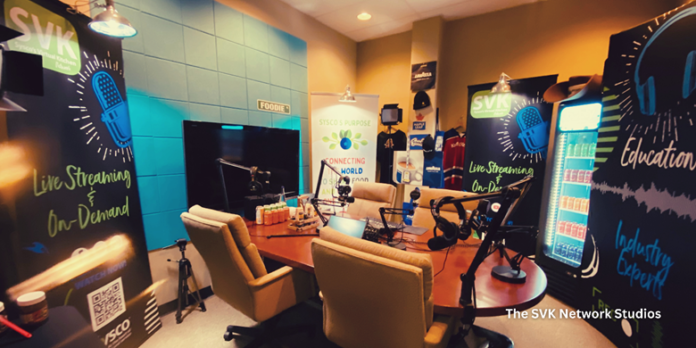
Golf courses looking to add extra income, particularly in the long off-season, may want to start thinking outside the box, like way outside the box.
Jay Ashton, business resources and activation manager for Sysco Canada, has some ideas, some really good ones. Of note, Ashton is also producer and host of Sysco’s Virtual Kitchen (on the SVK Network), an extremely popular show which has caught on in a big way on several social media platforms and provides plenty of useful information golf courses can use as they push forward and evolve along with the food and beverage industry.
First, a little about Sysco. Many golf courses are getting tremendous benefit as they lean on Sysco’s expertise and support. The global leader in selling, marketing and distributing food and non-food products to restaurants, healthcare and educational facilities, lodging establishments and other customers around the world, is a big name in the food and beverage industry, providing great synergy, support and resources for golf courses.
Part of that support comes with Virtual Kitchen, its enormously helpful and successful live podcast and streaming show – you can catch it on platforms like YouTube, Facebook, Spotify and iTunes. Or Google it. The show is something that can provide a lot of information and ideas for golf courses.
“We’ve really created the first food network with real people,” said Ashton. “There’s nothing like it in the industry. It’s continued to grow; we’re getting millions of views.”

So how does it apply to golf courses? There is helpful information on things like budgeting, marketing and leadership and everything in between. The show, which airs live each Monday-Friday and has had guests ranging from Bo Jackson to celebrity chefs, morphed out of COVID, starting on May 14, 2020. If you can’t catch it live, there’s a huge catalogue of shows you’ll find useful.
“It’s pretty cool, all of shows are 100 per cent live, there’s no pre-recording,” said Ashton. “We know what we’re going to say and what we’re going to do, but there’s no script. I don’t think there’s any company the size of us doing something like this. It shows who we are. Most companies polish up their content. But we believe in what we do.”
Ashton is an ideas guy. He’s got some suggestions that could be difference makers for golf courses. OK, so how do you find a way to increase revenue in golf’s season, which for much of Canada is from November to April? What about keeping your restaurant open year round and adding hospitality domes which can be spread around the golf course in winter? Maybe use a horse and sleigh to get people to the domed dining areas. Sound crazy? Actually, it’s an idea waiting to happen.
“There’s a lot of golf-course land not being used in the winter,” said Ashton. “People are looking for an experience. Put enclosures around the golf course, domes where people can dine out. The domes aren’t expensive anymore. You’ve got a beautiful landscape. Space them out over 18 holes, you can order food through your app. Imagine sitting in a glass dome at a table, you’re getting that awesome dining experience. People would pay a premium. The golf course is usually situated around a higher-income community. It’s a great opportunity. Even if you made just a little money, the PR and marketing you would get from that would be enormous.”
And there’s this. Golf courses really have an opportunity to re-invent themselves on the food and beverage side. Use the kitchen during the winter, maybe rent it out as a ghost kitchen.
“It’s really amazing what you can do with the kitchen rather than mothballing it for the winter,” said Ashton. “In Canada, where you shut down for several months a year, you can bring in that additional money which would really help with those slower days where you’re not seeing a lot of income. There’s not a lot of start-up; it’s pretty much plug and play. It could be huge. Broadcast on your social channels into your community, next thing you know you’ve got a pop-up ghost kitchen.”
Another change? How about re-evaluating the menu golfers are looking at on a daily basis. Evolve. You don’t have to eliminate the hamburger, fries and chicken wings mindset, but add wellness options to the menu. And with menus being digitalized, don’t be afraid to change it up regularly.
“We’ve done quite a few golf menus,” said Ashton. “The younger demographic is coming in for more of a wellness deal or healthier options – dishes that aren’t a whole bunch of grease. It’s shifting. We’ve seen halfway houses turn into a place where you can grab a booster juice.
“You look at your demographic. Who is at your course? The worst thing you can hear is the golfers asking each other, ‘Where are we going to eat, guys?’ You want to make sure they stay. You need healthier options, more functional foods, things that won’t make you feel sleepy. Add things that make you feel better. You have to consider that. Golf courses tend to be a bit more laggy, but we’re seeing menus change.”
As a food service provider, Sysco helps golf courses adapt, keep up in an industry that’s gone into “hyper speed” during COVID times. If you’re looking for more information, maybe on how to become a customer, go to sysco.ca. And make sure you tune into Sysco’s Virtual Kitchen – it could be a game changer for you.











